|
Kokopeli 2005 |

|
|
by Kim Apel - Los Angeles, California - USA |
The “Kokopelli Cruise” is hosted annually each fall by Jim Thayer. After many years at Lake Powell (Utah/Arizona), Mohave Lake was tried this year as an alternate venue, due to the extraordinarily low water level at Lake Powell. Though part of the same Colorado River system of reservoirs as Lake Powell, the water level of Mohave Lake is kept relatively stable.
 |
Jim Thayer and Ruby Gale cool off in Lake Mohave.
(click images for larger views) |
|
Eight Kokonauts gathered at the Cottonwood Cove marina near Searchlight, NV (same venue as several recent Scuzbum outings), and launched on September 18. Small boat celebrities Chuck Leinweber (founder of Duckworks website, from Texas)) and John Welsford (New Zealand small boat designer) were on hand to meet and greet and see us off; they had other fish to fry I guess. The Scuzbums were invited to participate, but unfortunately only I was able to attend.
| All 8 Kokonauts - back row: Ron Roberts' son (sorry, I forgot his name - Ed), Heather Gale, the author, Tom Gale, Ron Roberts. front row: Wil Gale, Ruby Gale, and Jim Thayer. |
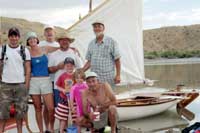
|
|
The first night’s destination for our little fleet was an attractive beach a few miles north, with a sweeping view down the lake. I liked the clean, round gravel that made up the beach. You could sit or lay on it and not pick up a load of sand or dust. The location offered good protection from the day’s southerly breeze, but would be unprotected should the wind turn northerly. I assured Commodore Thayer that such was unlikely in this season. I should have known from prior Mohave experience that wind behavior here is unpredictable. The next morning the Mohave weather gods proved me a liar and incompetent (again), and the wind turned north. We cruised to a more sheltered cove for the next night.
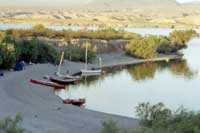 |
The first night’s destination for our little fleet was an attractive beach a few miles north, with a sweeping view down the lake.
|
|
On the last week of summer the lake was relatively peaceful; some jet skis and big powerboats were around, but not in the swarms sometimes seen. It was warm, but tolerable. The water was just right for swimming when it was time to cool off. Clouds moved in that evening and the humidity climbed. I’d forgotten about the possibility in September of “monsoon” weather and rain in the Mohave. Lightning flashed repeatedly to the west of us. Despite being a supposedly experienced camp cruiser, I’d come without a tent (anticipating heat, but not rain). I slept in the open, awakened a couple of times by light sprinkles. I re-pitched the shade canopy that I’d taken down for the night, relocated my bed, and thereafter listened to the pitter-patter of more showers safely under cover.
| We cruised to a more sheltered cove for the next night. |

|
|
I’d made macaroni and cheese for dinner that night, which was most appreciated by the kids who did not care for the spicy beans and rice dish that the grown-ups ate. I mixed the mac-n-cheese with my big wooden spoon. I couldn’t find it later during clean up; it was dark by then. No problem, I thought; I’ll find it in the morning. When morning came, the camp was awakened by a lone coyote yipping and barking from the lip of the wash in which we were camped. What really got us up and out of the sack, though, was when a whole chorus of coyotes answered back, in plain sight right across the cove from us, much closer and much louder than the solo caller. A little later I found the missing spoon a few steps from where I’d slept under the canopy. Last night’s residue of cheese sauce was gone and it had teeth marks all over it. I’m pretty sure that at least one of those morning yippers had been in our camp overnight. After the trip, my wife didn’t want that spoon back in her kitchen. I sanded out the teeth marks and re-oiled it. It has a place of honor now in my camp kitchen gear.
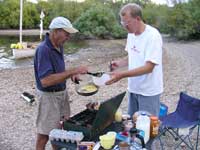 |
After the trip, my wife didn’t want that spoon back in her kitchen. I sanded out the teeth marks and re-oiled it. It has a place of honor now in my camp kitchen gear. |
|
The most interesting boat participating, I thought, was Tom Gale’s new creation, a self-designed and homebuilt row-sail-power combination dory. The design brief included: 1) big enough to carry the family and its related camping gear; 2) small and light enough to ride in tandem atop the other family boat (14’ FG Whitehall) on the trailer; 3) quick and inexpensive to build; 4) would row, sail and take a 2 hp motor; and 5) would inherit the existing sail rig from another boat. While Tom was pondering this need, he came across a poster of a Vincent van Gogh painting depicting a line of French fishing dories pulled up on the beach, each with a different colorful paint scheme. The most prominent one was red, black and white. That’s just what I’m looking for, he decided, and he built an approximate replica (in plywood, by eye) and painted it to match.
| The design brief stated that it had to be big enough to carry the family and its related camping gear |
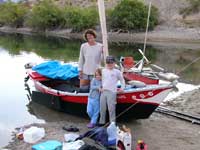
|
|
Tom and I went out for a sail one evening at sunset, when the lake and the surrounding desert are especially beautiful. It would have been perfect had the internal rudder post (which we learned was undersized and over-stressed in a good breeze) had not failed and dropped the rudder (metal: it was gone). Remarkably, the boat steered tolerably well by trailing an oar over the side, Viking-style. We returned under power after dark. It was a bit of a challenge just to find our camp.
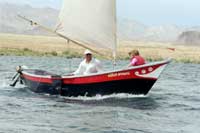 |
Tom and I went out for a sail one evening at sunset, when the lake and the surrounding desert are especially beautiful. |
|
The Kokopelli was a test of my scheme for a rowing/sailing/camping canoe for one. My canoe is a 17’-9”, 35 year old fiberglass Sawyer “Cruiser” model. (see Franken-boat … It’s Aliiive! by Kim Apel - Duckworks, December, 2005) When introduced, the Cruiser defined a new class of performance-oriented canoes, later developed by manufacturers Mad River and WeNoNah. Many still regard it with reverence, and I’m among them. Over the years, in addition to paddling it in the conventional manner, I’d adapted the Cruiser hull to sliding seat rowing, taken it camp crusing, and recently rigged it for sail. This was the first time I’d attempted to combine all three in one outing. It worked well enough, the main compromise being that the rowing seat has to be removed in order to sail. So one must begin in rowing mode, travel to a camping destination, unload gear and the rowing rig, and then rig for day sailing. Sailing this ultra-slender hull (even by canoe standards) is challenging. Sailing it with camping gear might be risky. Perhaps further development of the concept is possible. A proa perhaps or a trimaran? Hmmm.

sailing |
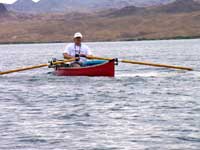
rowing
|
|
I went home happy, pondering a comparison with the experience of our exotic Canadian wilderness canoe trip back in July. Though I’m glad to have made the Murtle Lake trip, I had to admit that the fun-per-dollar ratio for the Mohave trip was much higher. On the other hand you could no more do the Mohave trip in summer (115 degrees) than you could do the Canada trip in winter (minus 15 degrees). I’m a fortunate guy to know both places.
| Tom Gale supervises as Jim Thayer cooks up some toast and sausages. |
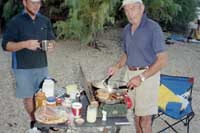
|
|
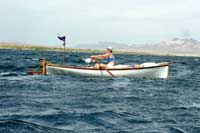 |
Heather Gale enjoys rowing her Whitehall. |
|
| Ron Roberts brought a canoe with outriggers, a sail rig and a front facing rowing rig. |

|
|
 |
Another look at Ron's boat
|
|
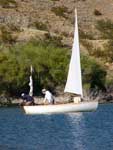
Jim Thayer's Nina |
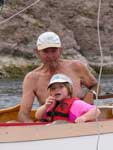
|

Heather sailing
|
|
| Ruby says: "Good Night" |
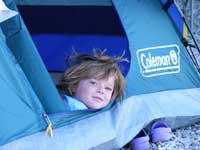
|
|
|